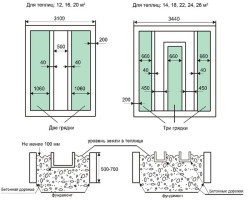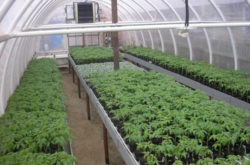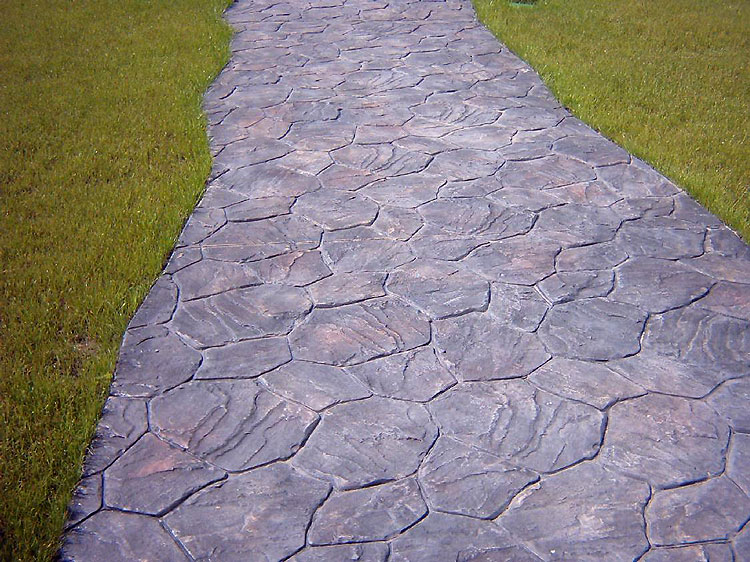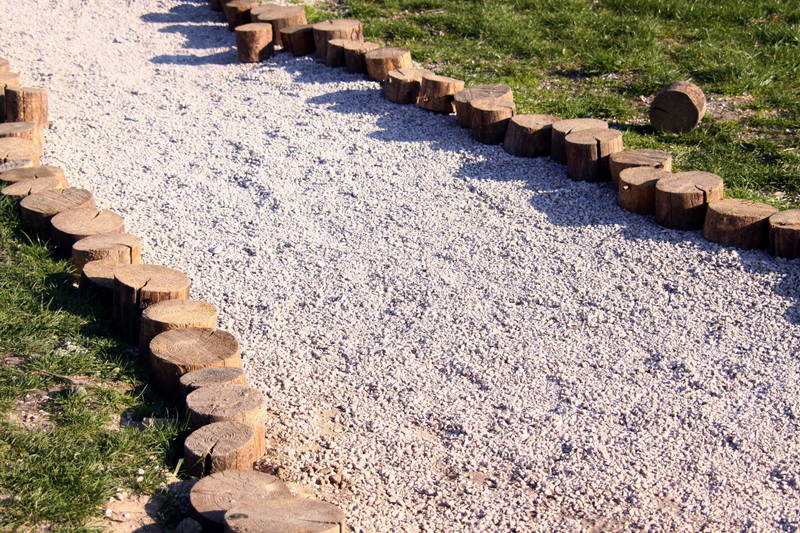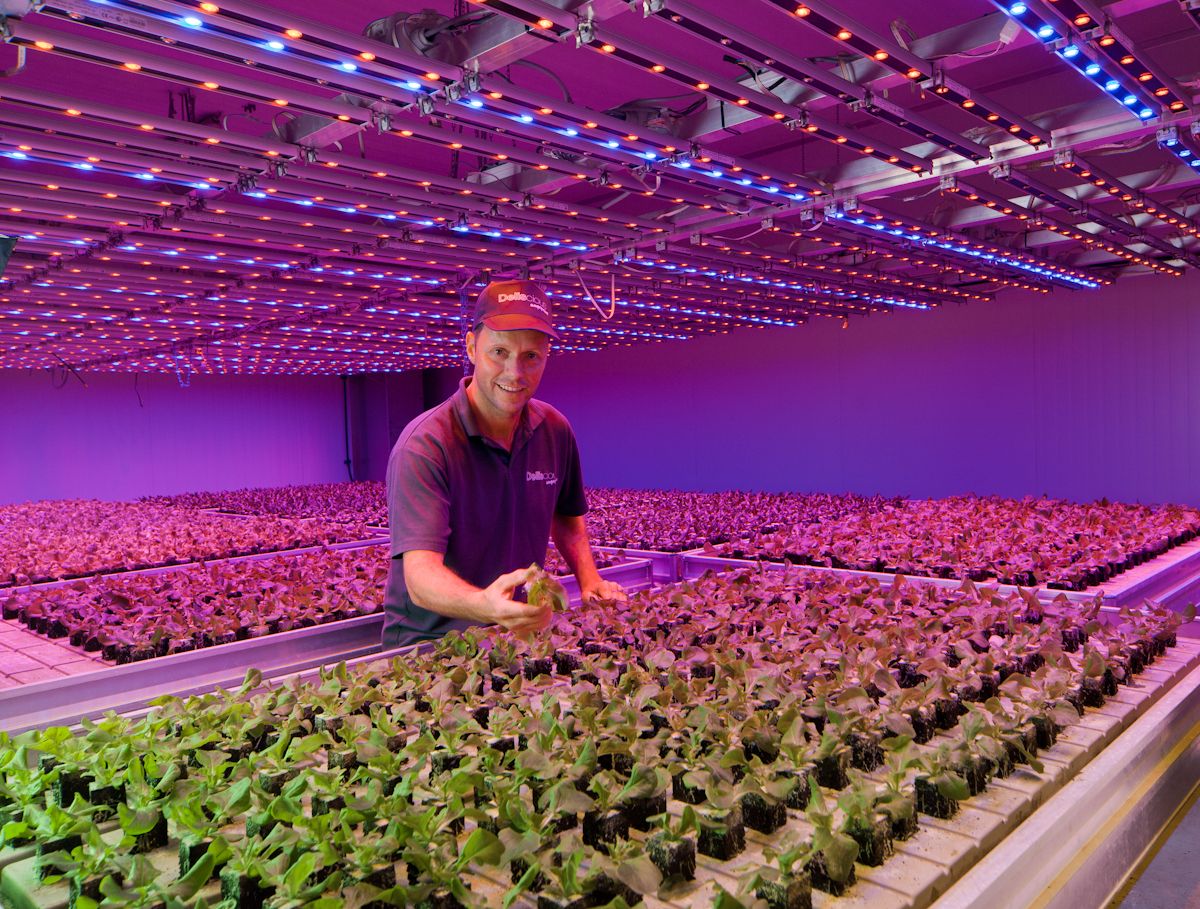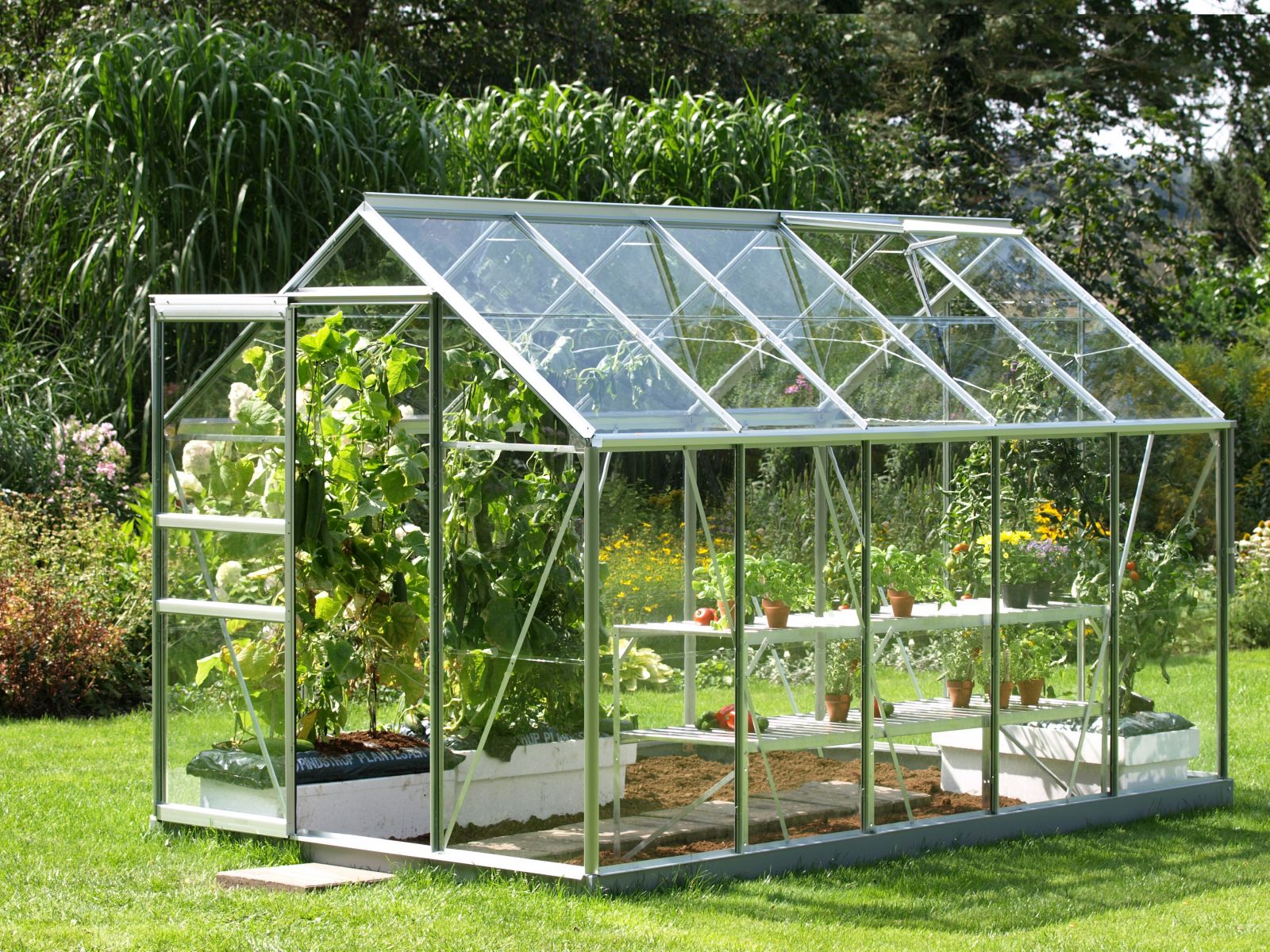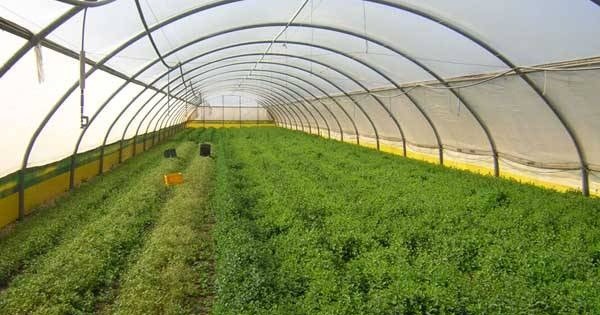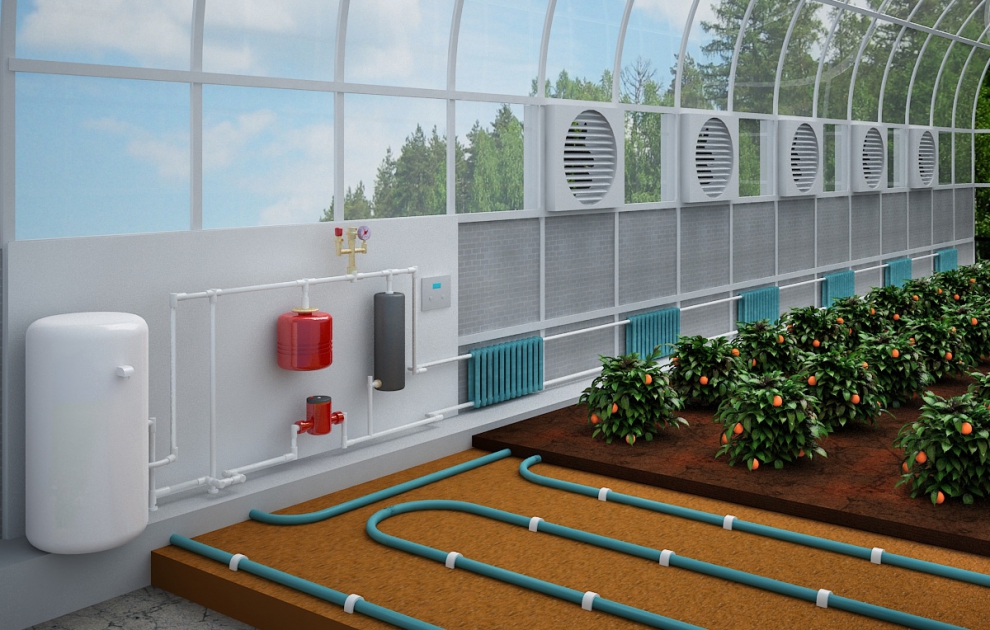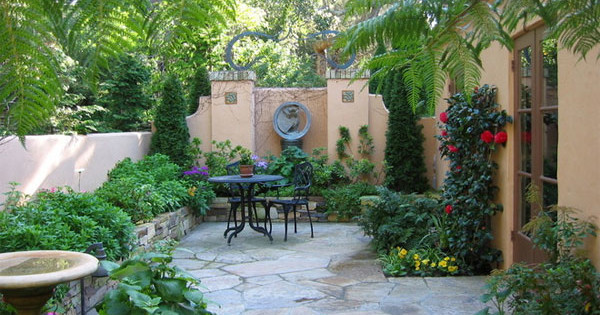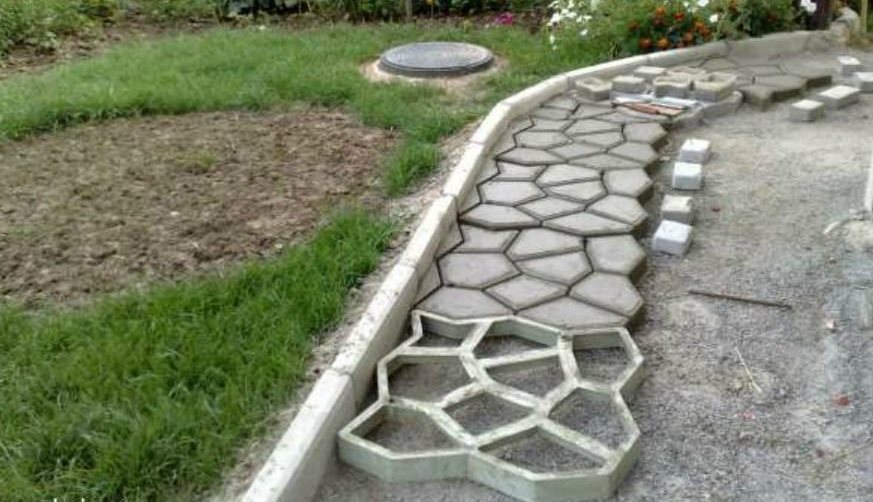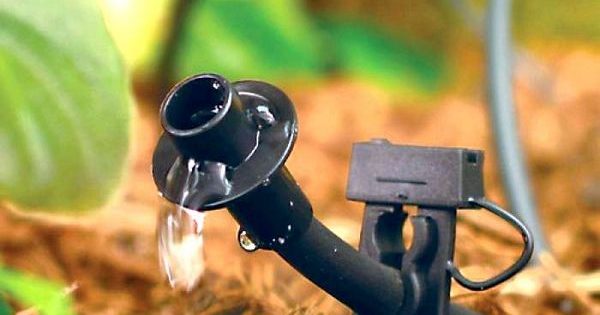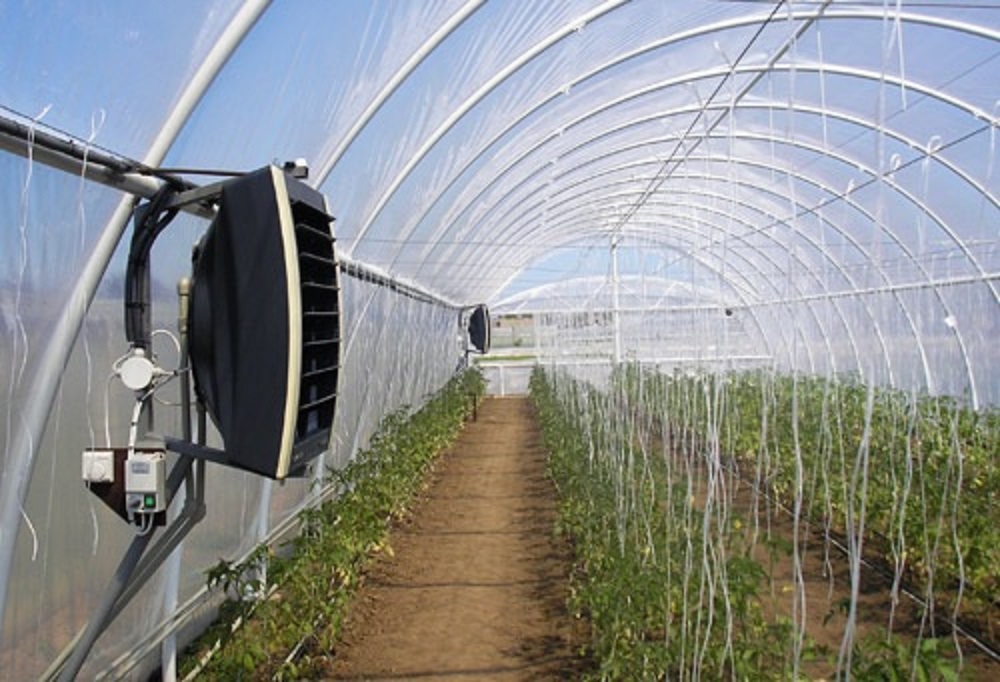Tips for arranging paths in the greenhouse with your own hands (13 design options)
Greenhouse - This is a great option for growing vegetation all year round. However, in order to collect a solid crop, it is necessary properly equip a greenhouse. Proper arrangement of paths in the greenhouse is also important, as is the internal organization of the frame and cover, because such walkways are both practical and convenient. Our article invites you to familiarize yourself with the recommendations for equipping paths in the greenhouse with your own hands.
Location of beds and paths in the greenhouse
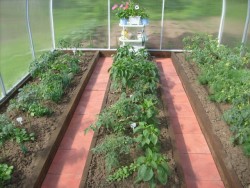 There are several varieties of arrangement of beds, the gardener gives preference based on the most suitable option for his greenhouse and planted plants.
There are several varieties of arrangement of beds, the gardener gives preference based on the most suitable option for his greenhouse and planted plants.
If the beds are broken inside and your structure is small, then you you need to make a track exactly in the middle. In this form, the beds will be on both sides of the aisle.
The track should be at least 500 mm wide, but you can arrange a passage of different widths, both larger and smaller. In the first case, more internal space is occupied, and this may adversely affect the quality and quantity of plants grown, for example, strawberries, and in the second, it will not be very comfortable for you to take care of the plants.
Awareness of this fact shows that the size of the beds of 500 mm is considered the most optimal.
Such a passage will be convenient for moving and caring for crops, but at the same time it will not affect the growth of plants.
 Regarding the temperature situation and the climate in the greenhouse, it is necessary to remember that the humidity level in the greenhouse is quite high and this can affect the material of which the path is made, as a result of this the best solution would be to use brick or fine gravel. Such a coating will be stable, and also guarantees minimal glide in conditions of high humidity.
Regarding the temperature situation and the climate in the greenhouse, it is necessary to remember that the humidity level in the greenhouse is quite high and this can affect the material of which the path is made, as a result of this the best solution would be to use brick or fine gravel. Such a coating will be stable, and also guarantees minimal glide in conditions of high humidity.- If it is necessary to equip a similarly large greenhouse in a much larger area, then in this case the beds are made wider, and accordingly arranging multiple tracks is the best solutionparallel to each other. And the beds will be located between these paths.
- It is necessary to equip the greenhouse with beds so that nothing interferes with comfortable care and watering. You need to understand that the execution of all processes takes place directly on the track. For example, in wide large greenhouses You can make several rows of bedsparallel to each other, and the tracks will occupy the desired position between them.
 When creating walkways, fences are of particular importance. Your greenhouse will look more neat and tidy if the tracks are clean and there is no land. Knowledgeable gardeners advise using boards, pre-treated with special tools against fungi and rot.
When creating walkways, fences are of particular importance. Your greenhouse will look more neat and tidy if the tracks are clean and there is no land. Knowledgeable gardeners advise using boards, pre-treated with special tools against fungi and rot.- To do this, make a small depression in the ground, the board is inserted sideways and dug in. You can make fences in this way: drive small pegs along the path, insert the board, resting on these pegs and directly install additional support on the other side of the side. Keep in mind that the edges of the fences should not be excessively high, as this makes crop care difficult. The optimum height of the side to protect the passage from the ground and pleasant care for the plants is about 20-30 mm.
Arrangement of paths in the greenhouse
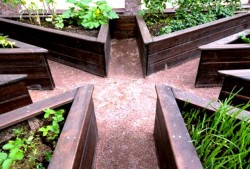 If the greenhouse is of any rectangular shape, made of polycarbonate, then in this case, you can make beds along the walls. To do this, it is necessary to lay a walkway from the entrance to the center of the greenhouse and several smaller tracks deep into the rows of beds.
If the greenhouse is of any rectangular shape, made of polycarbonate, then in this case, you can make beds along the walls. To do this, it is necessary to lay a walkway from the entrance to the center of the greenhouse and several smaller tracks deep into the rows of beds.
They advise not to leave the path unpaved so that it is not slippery, wet and practical.
If you plan to install in a greenhouse warm floor, then it must be laid under paths with all layers of soil, including drainage. Under pipes of that gender a heat-insulating layer is made of polystyrene foam or from a foil film. Such materials retain heat and do not allow to go deep into the earth.
What materials are used to create walkways in the greenhouse and in the garden?
The concept of an "experienced summer resident" implies an economical approach to arranging a greenhouse or greenhouse farm. Alleys in the country are created with your own hands from all available materials at hand. You can also add to this country-garden ingenuity and individual design.
What to make paths in a greenhouse (material review)
1. Paths of gravel, gravel
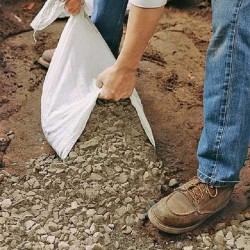 Recently, bulk paths made of gravel and gravel are very popular - they are simple, functional and unpretentious in maintenance, as well as affordable. Gravel material has several varieties:
Recently, bulk paths made of gravel and gravel are very popular - they are simple, functional and unpretentious in maintenance, as well as affordable. Gravel material has several varieties:
- Pebble - These are small pebbles of a rounded shape, which is poured with an even layer of about 5 cm. Fractions are characterized by a small adhesion to each other, as a result of which they immediately “creep” to the sides. Too much increase in the layer of the bulk pebble track makes it difficult to walk on it.
- Crushed stone gravel ("crushed stone") consists of fractions of different shapes, and this gives them a pretty good grip. The gravel path keeps its appearance well and does not create any inconvenience when walking along it.
- Crushed slate - such natural material is used in the arrangement of paths mainly for a decorative effect - near flower beds, shrubs, trees and other components of the greenhouse or garden.
Thus, gravel is excellent for arranging functional paths in a greenhouse, and is a promising and optimal option. For the construction of a gravel path, it is necessary to study in detail the placement methods, size, quantity, dimensions and all possible varieties of bulk material.
2. Paths made of natural stone (granite, limestone, sandstone, marble)
 To create a nice path in a greenhouse or in the country, you need to decide which natural material is most suitable. The basis for the greenhouse stone paths can be taken: sandstone, gravel, granite, dolomite, limestone, sea pebbles, paving stones.
To create a nice path in a greenhouse or in the country, you need to decide which natural material is most suitable. The basis for the greenhouse stone paths can be taken: sandstone, gravel, granite, dolomite, limestone, sea pebbles, paving stones.
Chipped and tiled stones have all the necessary properties for a stylish greenhouse path. However, this material has one drawback - high cost. But at the same time, a long service life, a high coefficient of strength and excellent decorative stone - completely compensate for this minus.
Consider the most popular types of natural material:
- Chipped paving stones. A special mixture of granite and shungite solid fragments with characteristic chipped sharp rectangular edges. Working with such tiles is easy and quick.
- Flagstone. This material contains fragments of various shapes and sizes, and this allows you to form an original and rather unusual path.
- Sawn stone. Before getting to the buyer, this product undergoes preliminary cutting and grinding - at the exit you will get a stone of rectangular shape with a smooth front and almost mirror face.
- Cobblestone and boulders. These stones are similar in round shape, but differ in size: the cobblestone is small, and the boulders are larger. The wide shade range of these natural gifts opens up unlimited space for amateur gardeners to create their own unique flower compositions and original patterns and elements.
What kind of natural stone you would not prefer - the creation of a greenhouse stone alley will begin with the design of its future contours. And this means that the size, shape and functionality of the path are determined by your wishes and needs. Therefore, first you need to mentally imagine your future path with all the nuances, and only then begin to act.
3. Paths from a terrace board
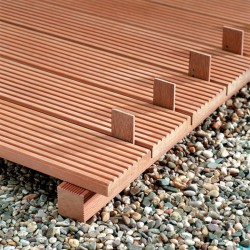 For flooring in greenhouses and greenhouses are often used terrace boards, which include natural materials with a wood-polymer composite. Such pieces are easy to install, come with additional elements (support beams, clamps, levels), are covered with "breathing" oils and are famous for their non-slip, pleasant surface.
For flooring in greenhouses and greenhouses are often used terrace boards, which include natural materials with a wood-polymer composite. Such pieces are easy to install, come with additional elements (support beams, clamps, levels), are covered with "breathing" oils and are famous for their non-slip, pleasant surface.
Wood is processed using special technology and as a result is stable and durable under mechanical stress, resists temperature fluctuations and high humidity, ultraviolet radiation, is resistant to various biological factors (rotting, fungi, bacteria and insect attacks), is not subject to deformation, and that most importantly, durable.
4. Paths from a wooden saw - turf (logs, hemp)
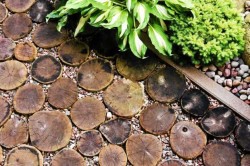 Sawing logs into small stumps of 10-20 cm, they can be used as a base for a greenhouse path or cottage.
Sawing logs into small stumps of 10-20 cm, they can be used as a base for a greenhouse path or cottage.
This is an economical budget option for building a walkway in a greenhouse with your own hands. However, it should be noted that this natural material is impractical - over time, the tree rots and crumbles. Even the most thorough treatment of wood with antiseptics and paints, does not guarantee durability. The maximum life of the turf flooring is approximately 10-12 years.
At the same time, numerous variations of combined paths using chopped wood bark, shavings, sawdust and concrete slabs, or wood with brick borders, etc. look beautiful and cozy.
5. Rubber tracks (tires)
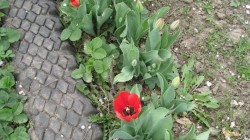 Track of old car tires differs in high quality, durability, resistance to external weather influences, has anti-skid and its most important feature is simplicity and ease of creation.
Track of old car tires differs in high quality, durability, resistance to external weather influences, has anti-skid and its most important feature is simplicity and ease of creation.
- When equipping paths in a greenhouse or garden, you can make your own flooring from old tires or use a special one rubber tile - a product of the processing of these tires. Such a path will be more neat and beautiful.
- Tape of the same size easily fits and mounts. The track can be of different widths and consist of several tread belts, but there must be a small gap between them - this will provide a drain of water and quick drying of the flooring.
- Rubber track - This is a great way without significant costs to make a convenient and safe passage along the beds of the greenhouse.
6. Concrete tracks (cement mortar)
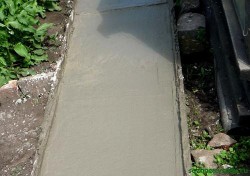 One of the budget and simplest ways to solve the problem of convenient movement along the beds and the design of the tracks in the greenhouse is to fill in the prepared formwork of a special cement mortar.
One of the budget and simplest ways to solve the problem of convenient movement along the beds and the design of the tracks in the greenhouse is to fill in the prepared formwork of a special cement mortar.
- Concrete is durable, resistant to various climatic and mechanical influences. For the competent design of paths inside the greenhouse, it is necessary to calculate its area, as well as calculate the amount of required materials. Having drawn up a plan, having calculated all the expenses and having prepared the necessary materials, we can proceed with the breakdown.
- Work with cement mortar includes the mandatory observance of all time cycles. The strength of the concrete alley depends on the speed of casting, the absence of interruptions in work. For these reasons, all the necessary tools and materials are fully prepared in advance for the creation of paths in the greenhouse with their own hands.
- To facilitate the creation of a cement track, you can use plastic patterns (forms) - a special stencil, of various configurations and sizes, which is filled with a solution.
7. Paving slabs
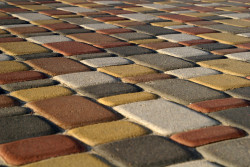 Making tracks in a summer house or a greenhouse with of this popular building material It will cost you inexpensively, and at the same time will make it easy to translate design and creative ideas.
Making tracks in a summer house or a greenhouse with of this popular building material It will cost you inexpensively, and at the same time will make it easy to translate design and creative ideas.
Paving slabs are made from natural eco-friendly components and have the following advantages: It is resistant to various weather conditions, has increased strength, thereby ensuring the durability of the path, and is easy to care for..
Laying of paving slabs is carried out on the basis of a sand cushion and is considered quick, easy and economical. For the construction of paths in a greenhouse or in personal territory you will need only a few components: concrete concrete tiles, clean sand and cement mortar.
8. Brick walkways
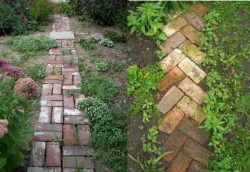 Brick similar in physical properties to paving tiles. However building brick not suitable for forming tracks. It is not resistant to water, to constant contact with the soil. And after 5-10 years it will be deformed and crumble.
Brick similar in physical properties to paving tiles. However building brick not suitable for forming tracks. It is not resistant to water, to constant contact with the soil. And after 5-10 years it will be deformed and crumble.
Choosing the right brick, it is necessary to make preliminary calculations of the area and quantity of material. This material allows you to lay out paths in various ways.
The general style of landscape design and the own plan of summer residents make it possible to use different types of brickwork: parquet, diagonal, straight with a shift of stripes, circular, Venetian masonry in the form of scales and its varieties.
9. Paths made of artificial stone (clinker)
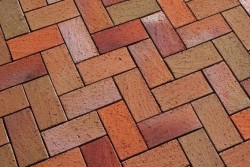 To create a passage in the greenhouse and hotbeds, a high-quality grade of wall brick is used, or clinker brick. “Artificial” characteristics and outstanding decorative features are inherent in such an artificial stone.
To create a passage in the greenhouse and hotbeds, a high-quality grade of wall brick is used, or clinker brick. “Artificial” characteristics and outstanding decorative features are inherent in such an artificial stone.
This material is gaining more and more popularity among gardeners. It is highly durable, beautiful and is presented in a wide assortment on the construction markets - this makes it possible to choose the color and texture of the future “road” for any, most demanding taste.
10. Plastic tracks (decking)
 A good solution for arranging paths in a greenhouse is plastic. This building material is inexpensive, practical and easy to maintain, resistant to biological influences and operational loads. A special corrugated coating is able to prevent slipping during high humidity in the greenhouse or during rain in the area.
A good solution for arranging paths in a greenhouse is plastic. This building material is inexpensive, practical and easy to maintain, resistant to biological influences and operational loads. A special corrugated coating is able to prevent slipping during high humidity in the greenhouse or during rain in the area.
- For plastic coatings, an imitation of various textures is characteristic - tiles, wood, natural stone, marble, metal, ceramics and others. As a result, plastic is very popular in decorating.
- Outstanding attractiveness is possessed by a special plastic tile called decking (tile from several connected boards). In its composition, it has wood flour and various polymer additives. Such a flooring will look like an ordinary parquet board.
- You can easily make a garden path or a passage in a plastic greenhouse with your own hands, using such improvised material, like plastic bottles. To do this, you will need to choose from - lids, pieces, pieces or whole bottles.The walkway will look more interesting and more creative if, before filling inside the sand mixture, you place multi-colored candy wrappers, pebbles, glass pieces, pieces of paper or foil in the bottle container.
11. Grass paths
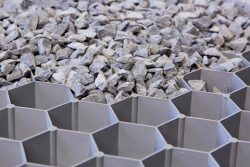 Another affordable track path for a greenhouse or garden is the use of lawn grilles. Thanks to them, you can strengthen the lawn to walk on it without undesirable consequences. And for the greenhouse, you’ll also get a good eco-friendly path. To lay such an element, you need to make a base - a sand and gravel pillow. You can also put lawn plastic directly on the grass, without preliminary work.
Another affordable track path for a greenhouse or garden is the use of lawn grilles. Thanks to them, you can strengthen the lawn to walk on it without undesirable consequences. And for the greenhouse, you’ll also get a good eco-friendly path. To lay such an element, you need to make a base - a sand and gravel pillow. You can also put lawn plastic directly on the grass, without preliminary work.
A lawn grate is placed on the prepared area. To fall asleep, a mixture of fertile soil, grass seeds and various fertilizers is used. It is necessary to water such a floor several times a day. And then - the track is used for its intended purpose.
12. Paths of glass rubble, glass chips
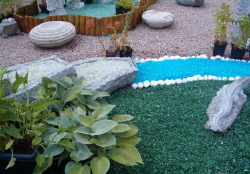 This summer cottage decision gives priority to aesthetics and style. The financial side of the issue is secondary. Today the easiest way to beautifully design a glass walkway is to fill it with colorful glass rubble. This is not specially broken glass, but an industrial material, without sharp edges and chips, so you can safely walk along such a path without shoes.
This summer cottage decision gives priority to aesthetics and style. The financial side of the issue is secondary. Today the easiest way to beautifully design a glass walkway is to fill it with colorful glass rubble. This is not specially broken glass, but an industrial material, without sharp edges and chips, so you can safely walk along such a path without shoes.
- It is worth noting that, nevertheless, such a track is “expensive” will cost the owners. The price of glass material is from about $ 1 per 1 kg. And for the average country path with a length of about 10 m, about 200 kg of “glass” will be required. But the effect is amazing! With the right garden lighting such a sparkling inlaid alley will become the main attraction of the cottage and garden.
- A path from a glass rubble is created quickly and easily. Marking is done, the soil layer is removed at a depth of 10-15 cm. Experienced gardeners use a mixture of geotextiles for the lower layer. Such a connection prevents the settling of glass gravel, prevents erosion and protects against unwanted vegetation. Top layer of geotextile about 2.5 cm thick crushed stone is poured. And your glass path is ready!
- For the greenhouse, you can make borders - a number of small pebbles of various shapes, and all this in a complex will harmoniously look with the surface, with beds and give a complete, well-groomed look.
13. Paths of glass bottles
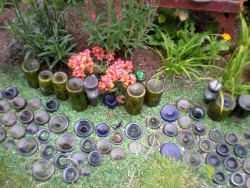 For stacking paths in a greenhouse using whole glass bottles or for laying out of them an original and beautiful ornament on a garden plot, first of all, you will need to get somewhere in a large amount of glass material.
For stacking paths in a greenhouse using whole glass bottles or for laying out of them an original and beautiful ornament on a garden plot, first of all, you will need to get somewhere in a large amount of glass material.
The arrangement of the path involves preliminary marking of the future passage or the desired figure, pattern. At the place of the track, soil is selected to the appropriate depth (by bottle height). Glass containers are installed bottom to top, close to each other, and the distance and openings between it are covered with soil. Having made a couple of such rows, it is necessary to fill the cracks with water, so that the soil settles, and be sure to add more. Heavy rains will contribute to the fact that the earth will sink even more, and then it is recommended to add sand from above. Thanks to such wonderful glass paths, the greenhouse will be transformed internally, and a nondescript summer cottage will sparkle with multi-colored lights.

